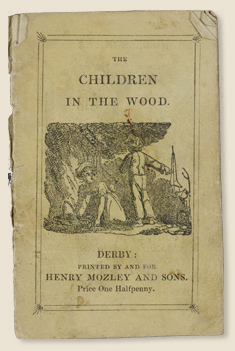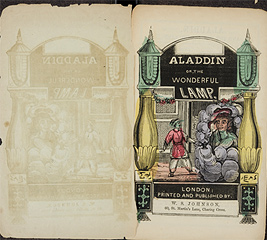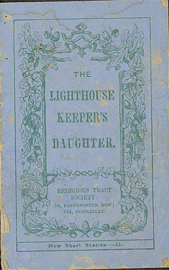Chapbooks can be loosely defined as the small, unbound, paper-covered books that were carried and sold by itinerant peddlers known as "chapmen". They were in circulation from the sixteenth century until the early nineteenth century and, although the term 'chapbook' has sometimes been employed as a "conscious archaism" (Carter 62), especially for small-press poetry volumes, it has not been in current use since about 1830. In fact, until Jan Fergus uncovered evidence of its use as early as 1747, it was long believed that the term "chapbook" was a nineteenth century convention and that it was used retrospectively to describe "a form of literature that had by then vanished" (Grenby 278). The term "chapman" derives from the Anglo Saxon ceapman, which is a combination word meaning trade + man, but many scholars have speculated that the prefix "chap" might be a corruption of the word cheap, and therefore refers to the quality of the literature.
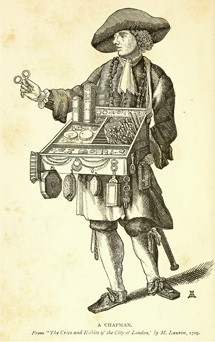 Chap-books of the eighteenth century
Chap-books of the eighteenth century
One of the problems with attempting to reach a ubiquitous and succinct definition of the chapbook is that the literature itself resists any such effort. Although the chapbook has been defined rather narrowly at different times throughout history, traditionally referring only to those works carried by itinerant peddlers, the term has come to broadly represent a body of work that spans four centuries as well as several distinct and seemingly dissonant literary genres. A great number of chivalric romances, adventure tales, histories, children's books, songbooks, and temperance tracts, which were written at different times and for different audiences—and as a result, differ greatly from one another in terms of content—are often collected under the general rubric of 'chapbook.' This is because they all share one or more characteristics in terms of price, format, tone, production, or distribution. As a genre, the term chapbook "is not without coherence" (Pedersen 103), however, as many critics have suggested, a blanket definition of the term can obscure more than it reveals. For example, Matthew Grenby is sceptical of any definition that attempts to make generalizations across the entirety of chapbook literature. Instead, he suggests that chapbooks typically adhere to strict limitations within one or more of the following four criteria: format, price, distribution, and content.
 PN970 B66 C46 1780
PN970 B66 C46 1780
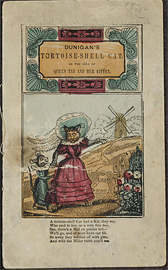 PN970 A1 D865 1800Z
PN970 A1 D865 1800Z
First, in terms of physical form, chapbooks were small, unbound books that featured the title page printed on the first leaf in lieu of a cover. There were two broad groupings in terms of size. Although most chapbooks measured 3 ½ by 6 inches, beginning in the early eighteenth century, chapbooks marketed towards children could be as small as 2 by 3-½ inches. However, despite these differences in size, both groups typically consisted of twelve or twenty-four pages, and both were made from one or two sheets of paper, folded and stitched, with crude woodcuts alongside the letterpress.
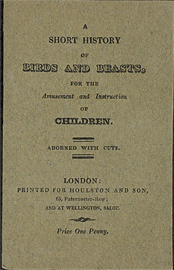
PN970 H68 S56 1828
Second the price: at a penny or less the chapbook was a comparatively cheap form of literature. This gave chapbooks a wide appeal among members of the lower classes who could read, but lacked the resources to purchase expensive literature. However, even at the cost of a penny, chapbooks were too expensive for labourers to purchase often, and were seen as somewhat of a luxury. In the mid-sixteenth century, a twopenny chapbook would have been "one fifth to one quarter" of a craftsman's daily wages (Watt 261). By the mid-seventeenth century, when he was making up to 16d., the regular purchase of a twopenny chapbook became more affordable, although this still might have entailed "sacrificing two quarts of strong beer at the alehouse" (watt 262). Furthermore, chapbooks were often passed around, which means that even those at the lowest levels of society, who could never afford to purchase even one chapbook, could nevertheless participate in the 'little tradition' of popular culture.
Third, the method of distribution: chapbooks were carried and sold by "itinerant peddlers" (Grenby 278) known as chapmen, rather than booksellers, which means they were more available than standard publications to those who lived in rural areas and who did not have convenient access to markets.
And finally, the content: chapbooks typically featured non-didactic tales of romance and adventure, and were "often abridged from longer works" (Grenby 278). In the late eighteenth century there were several attempts on the part of evangelical societies to appropriate the chapbook format for didactic purposes. These later works, however, stand in stark contrast to the unruly and amoral chapbooks of previous centuries and should not be considered chapbooks according to a narrow definition of the term.
Although these criteria can be generalized to chapbook literature as a whole, none constitute what could be called a universal rule, and none is without exception. There were gradual shifts, from one century to another, between which of these four elements was emphasized as the defining feature of chapbooks. In the sixteenth and seventeenth centuries the chapbook was defined primarily as any literature distributed by chapmen, but by the 18th century, the "plebeian tone" (Grenby 278) had become a more important precondition. Susan Pedersen suggests that the chapbook "is remarkable precisely for its variety," (Pedersen 99) arguing that the generic diversity of chapbooks is itself a defining feature of the literature. Andrew O'Malley prefers to limit the term to an "expression of plebeian popular culture" (O'Malley 20), in order to maintain a formal generic distinction between "genuine" chapbooks and their imitators. In the late eighteenth century, evangelical publications such as Hannah More's Cheap Repository Tracts (CRT), and the Religious Tract Society (RTS), attempted to use the chapbook format as a vehicle for social reform. Although these would not be considered chapbooks according to O'Malley’s narrow definition, they are often preserved in chapbook collections because they appropriated the style, format, and distribution networks of genuine chapbooks.
| < Prev | Next > |

